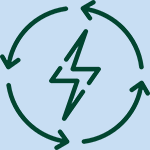
Why Prolong the Life Cycle of Data Center Hardware?
Data center hardware has traditionally been subject to relatively short life cycles, often replaced every third year.
In recent times, however, there has been a growing realization of the benefits of prolonging the life cycle of data center hardware.
This blog explores the advantages of this approach, from cost savings to reduced environmental impact.

1) Cost Savings:
One of the most apparent advantages of extending the life cycle of data center hardware is cost savings. Replacing hardware components or entire systems can be a significant capital expenditure. By prolonging the life of existing hardware, organizations can delay these expenditures, thereby conserving financial resources. This approach is particularly appealing for organizations with tight budgets, as it allows them to allocate funds to other critical areas.

2) Energy Efficiency:
Another key advantage of extending the life cycle of data center hardware is improved energy efficiency. Newer hardware often comes with enhanced energy-saving features and improved performance per watt. However, the energy required to manufacture and dispose of old hardware can outweigh the energy savings of upgrading. By using existing hardware for a more extended period, data centers can reduce their environmental footprint by minimizing the energy-intensive manufacturing process.

3) Reduced E-Waste:
The disposal of e-waste, is a significant environmental concern. When data center hardware reaches the end of its life cycle, it can contribute to the growing e-waste problem. Prolonging the use of hardware means fewer components end up in landfills, reducing the environmental impact associated with electronic waste disposal. Additionally, organizations can explore recycling and responsible disposal options to further mitigate their environmental footprint.

4) Improved Return on Investment:
Extending the life cycle of data center hardware can significantly improve the ROI. When organizations invest in new hardware, they often expect to recoup their investment over time through improved performance and efficiency. However, extending the life of existing hardware can provide a more extended period to realize this ROI. Organizations can maximize the value of their initial investment, making it a more financially prudent decision.

5) Stability and Compatibility:
New data center hardware often comes with compatibility challenges. It may require updates to software and systems, which may cause downtime. By sticking with existing hardware, data center operators can maintain stability in their operations, avoiding the potential disruptions that come with frequent upgrades. This approach also allows for better planning and testing to ensure a smooth transition when upgrades eventually become necessary.

6) Sustainable Practices:
Sustainability has become a cornerstone of modern business practices. Prolonging the life cycle of data center hardware aligns with sustainability goals by reducing waste and energy consumption. Companies that prioritize sustainability not only reduce their environmental impact but also improve their reputation and appeal to environmentally conscious consumers and investors.
Third party maintenance (TPM) is one step to reducing CO2 emissions. As original equipment manufacturers (OEMs) offer warranty support sometimes only up to 3 years, this support can be extended through third-party maintenance providers. TPM can help you prolong the use of data center hardware when it is at the end of service life (EOSL). Data center hardware can function effectively for 10 or even 15 years; therefore, buying new equipment when the existing one is at the EOSL has unnecessary environmental and financial costs.
Another way of reducing CO2 emissions is to reuse the hardware. By purchasing refurbished data center hardware, you help prolong the life cycle of hardware that has not been used to its maximum capacity. This way, you can postpone investment into new equipment and reduce your overall carbon footprint.
Extending the life cycle of data center hardware offers a host of advantages, ranging from cost savings and energy efficiency to reduced e-waste and improved ROI. Embracing this approach can help organizations navigate the ever-evolving landscape of technology while also contributing to more sustainable and environmentally responsible practices. By carefully evaluating when hardware upgrades are truly necessary and making strategic decisions, data center operators can optimize their operations and achieve long-term success.
If you have further questions about sustainability within the data center sector, our TPM or refurbished data center hardware, do not hesitate and e-mail us at sales@nordiccomputer.com. Or contact us by filling out the form below.